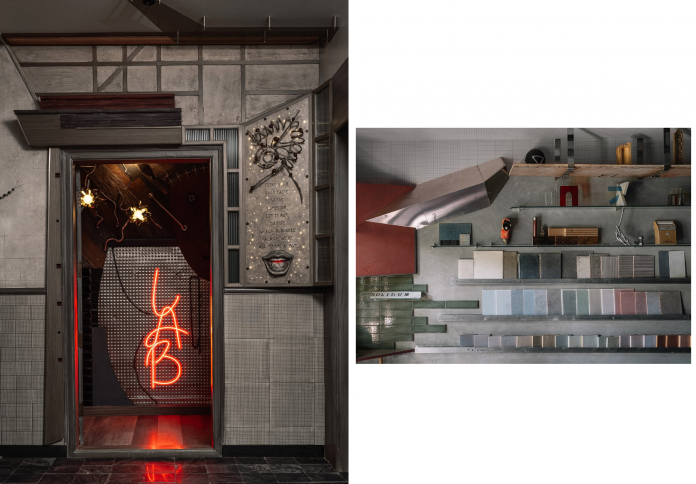In a profound commitment to sustainable design and creative reuse, the Bengaluru studio Multitude of Sins has transformed a former residential apartment into its own material lab and research space. Named Requiem for Ruins, the project is a striking “spatial memoir” constructed almost entirely from materials that society had discarded—rejected samples, broken prototypes, and construction waste. By deliberately delaying the design process to quietly collect these fragments over two years, the studio achieved an astonishing figure: approximately 95 per cent of the space is built from salvaged waste. This project moves beyond mere recycling; it is a philosophical statement that views discarded elements not as trash, but as “overlooked pieces” capable of being reimagined into forms that are both profoundly functional and truly artistic. The resulting lab is an ever-evolving narrative, where every chipped tile and warped fragment adds a new, indelible sentence to an expanding text.
The Philosophy of the Spatial Memoir
The concept of the “spatial memoir” is the philosophical core of Requiem for Ruins, defining the space as a living document of its own construction history and the objects that compose it. Studio founder Smita Thomas articulated that the lab is a record of “chipped tiles, warped MDF, and forgotten attempts,” treating these discarded pieces with the same reverence one would afford treasured artifacts. This deliberate shift in perception is central to the project’s success, revealing that what is often dismissed as useless construction debris can be re-approached thoughtfully and transformed into powerful new forms.

The very essence of the design is elastic and invites the unfinished, the fragment, and the discarded. Thomas explained that the lab’s evolution is not predicated on changing its form entirely, but on “deepening narrative where every prototype, every overlooked sample becomes another sentence.” The space is structured to grow the way memory grows: by layering, not by replacing. This commitment to continuous narrative means the lab is constantly changing, absorbing new fragments of waste as they emerge from the studio’s other projects, ensuring the space remains a dynamic, living testament to sustainable practice and creative memory.
The Layout: A Collection of Research Nodes
Requiem for Ruins is cleverly partitioned into several distinct areas within the former apartment’s footprint, designed to accommodate research, creative collaboration, and client interactions. The space includes a core lounge and selection area, a pantry, a store room, and two dedicated meeting rooms. The layout is arranged to guide visitors through an immersive experience of salvaged materials and architectural invention.

The lab’s entrance sets the stage, framed by an assortment of construction debris. Immediately inside, a sculptural panel engraved with the studio’s motto uses wire and lightbulbs resembling stars, a striking, poetic use of seemingly mundane objects. At the heart of the space lies the selection area, dominated by a central, 12-foot-long table. This essential piece of furniture is a composite work of art, crafted from an unlikely mix of scrap marble fragments, plywood offcuts, and mesh. The conversion of the apartment’s original bedrooms into functional work zones—one dedicated to vendor meetings and the other for the in-house team—further maximizes the utility of the reclaimed residential volume for its new purpose as a vibrant research hub.
Innovative Use of Found Materials
The genius of the lab lies in the innovative and resourceful application of specific waste materials, proving their aesthetic and functional potential. In the central lounge, the studio employed materials like scrap chains, perforated metal sheets, and surplus brass knobs to create unique detailing and furniture. Even design failures were given new life: wooden beading samples created for a previous project were repurposed to create floating bookshelves, while excess acrylic sheets from another job were transformed into light fixtures.

In the selection area, an old, discarded staircase railing was given a completely new life, repurposed to create a pegboard capable of displaying over 300 material samples—a beautiful and functional piece of upcycling. A desk and storage system below this pegboard were ingeniously fashioned from 24 wire mesh baskets sourced from IKEA. Even the circulation spaces became canvases for material innovation: a staircase leading to a future expansion space was adorned with a sculptural railing featuring geometric shapes made from acrylic offcuts, transforming a transitional space into a design installation.
Artistic Installations and Textural Drama
The studio used discarded elements to create dramatic, site-specific installations, developed in collaboration with local artisans, that provide visual anchors throughout the lab. In the vendor meeting room, the walls are characterized by a powerful, three-dimensional zigzag installation made from folded pieces of waste plywood, MDF, and blockboard. This installation, featuring a strong crimson hue, showcases how otherwise unremarkable wood composites can achieve a complex, sculptural form.

Another striking installation is suspended from the ceiling of the main corridor, created from backlit acrylic panels and discarded junction boxes. The use of light interacting with these salvaged components transforms simple utility waste into a source of ambient lighting and abstract pattern. At the corridor’s terminus stands a feature wall that acts as a visual memoir of industrial waste: it is clad with a dense composition of metal offcuts and surplus bricks arranged to resemble a steampunk-style tree. To complete the arboreal metaphor, a prototype of a rejected MDF artwork from a previous project was fixed at the top to serve as the ‘canopy,’ marrying design prototypes with construction waste in a single, powerful image.
Reimagining the Everyday Utility
Even the most utilitarian spaces and objects within the lab were subjected to the studio’s rigorous philosophy of reuse and reinvention. In the second meeting room, the ceiling was treated with a bespoke, textured finish of abstract MDF shapes, demonstrating that even this simple, mass-produced material can achieve an artistic, ceiling-defining effect. This artistic approach extends down to the functional details.

In the pantry, a room dedicated to the simplest daily rituals, the creative use of scrap material is evident in the ceiling’s edge, which is lined with plywood scraps. Most inventively, a discarded drum dolly—a simple, wheeled mechanism used for moving barrels—was completely repurposed and transformed into a striking, unique light fixture. These small-scale inventions, using readily available or discarded commercial objects, underscore the central tenet of Requiem for Ruins: that every piece of waste, no matter how humble or function-specific, holds the potential to be a creative and structural asset within a new, layered architectural narrative.










